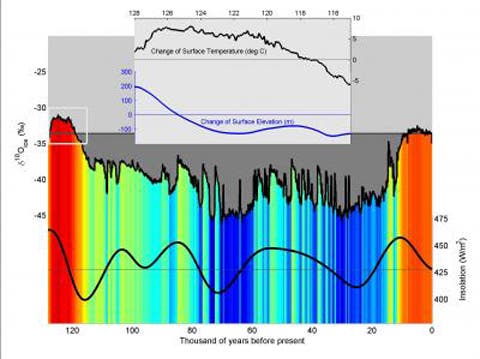A newly published massive study, where some 133 scientists collaborated, revealed that during our planet’s last warm period between ice ages the Greenland ice sheet was still fine and sturdy, despite it was a lot shorter than it is today and caused an increase of a few feet in world sea levels. The authors involved in the paper warn that carbon dioxide levels are on par with current trends and if things continue to remain as now in terms of greenhouse gas emissions, then Greenland might irreversible dump its fair share of ice in the near future.
The four year long study was a veritable challenge for the international team of researchers, who analyzed ice core samples from the Greenland ice sheet, some 1.5 miles long. These samples served as time capsules, allowing the scientist to backtrack Earths’ climate far into the past, offering highly accurate and valuable data concerning temperature, ice sheet size and even atmospheric conditions. A certain heavy oxygen isotope, O18, came particularly in handy.

What interested the scientists most was the Eemian period, around 115 to 130 thousand years ago or better known as Earth’s last (very warm) interval between ice ages. Apparently during this time the region was 8 degrees Celsius warmer; that’s much warmer than it’s forecast to get in the coming decades. Apparently the ice sheet in Greenland withstood these high temperatures for 6,000 years, not without shaking some ice though.
In the Eemian the world’s oceans were four to eight meters higher than today, however the ice sheet in northwest Greenland was only a few hundred meters lower than the current level. This means Greenland ice sheet had a far less contribution to the global sea rise than previously thought, prompting scientists to direct their attention towards Antarctica which has always been the hardest environment to study.
Also, in a remarkable find scientists estimated that between 122,000 and 115,000 years ago, Greenland’s surface elevation had dropped to about 425 feet below the present level as a result of melting. The scientists however paint a gloom picture of the future and lament the current poor state of awareness regarding the impending peril our grandchildren will face at the cost of present day comfort.
“Unfortunately, we have reached a point where there is so much carbon dioxide in the atmosphere it’s going to be difficult for us to further limit our impact on the planet,” co-author Jim White, the director of the University of Colorado, Boulder’s Institute of Arctic and Alpine Research, said in a separate statement. “Our kids and grandkids are definitely going to look back and shake their heads at the inaction of this country’s generation. We are burning the lion’s share of oil and natural gas to benefit our lifestyle, and punting the responsibility for it.”
“We were quite shocked by the warm surface temperatures observed at the NEEM ice camp in July 2012,” said Dahl-Jensen. “It was raining at the top of the Greenland ice sheet, and just as during the Eemian period, meltwater formed subsurface ice layers. While this was an extreme event, the present warming over Greenland makes surface melt more likely, and the predicted warming over Greenland in the next 50-100 years will very likely be so strong that we will potentially have Eemian-like climate conditions.”
Findings were documented in a report published in the latest edition of the journal Nature.






